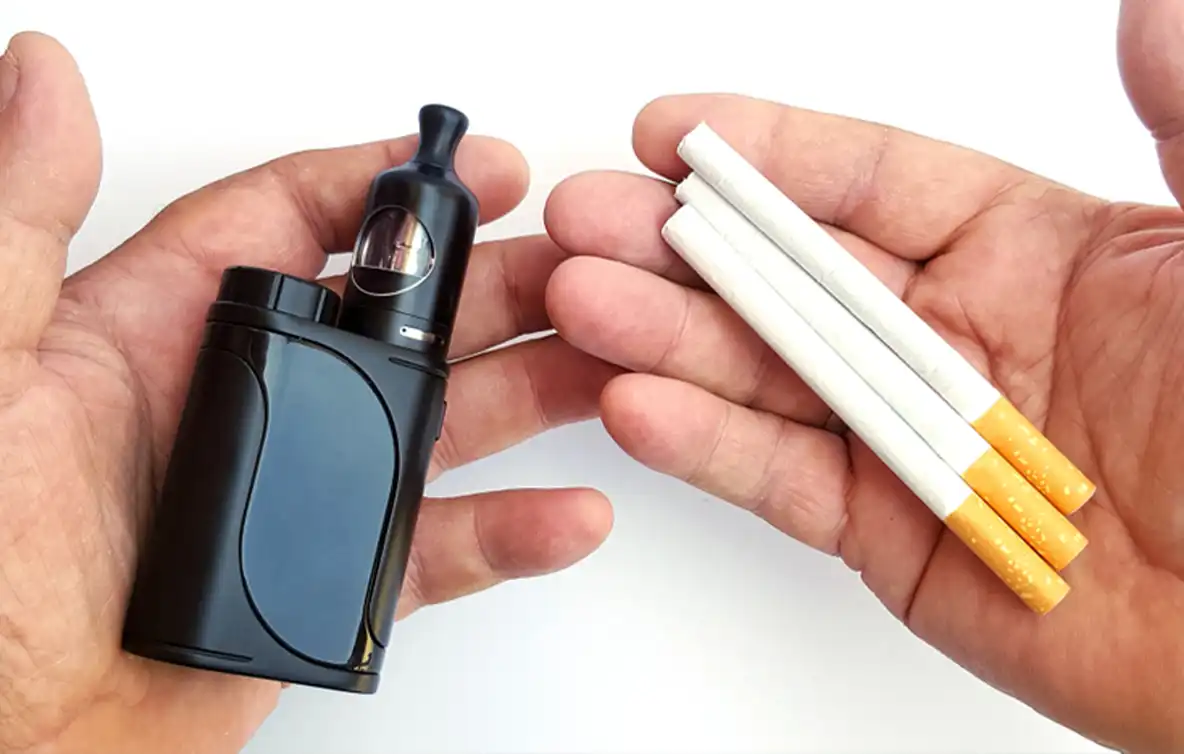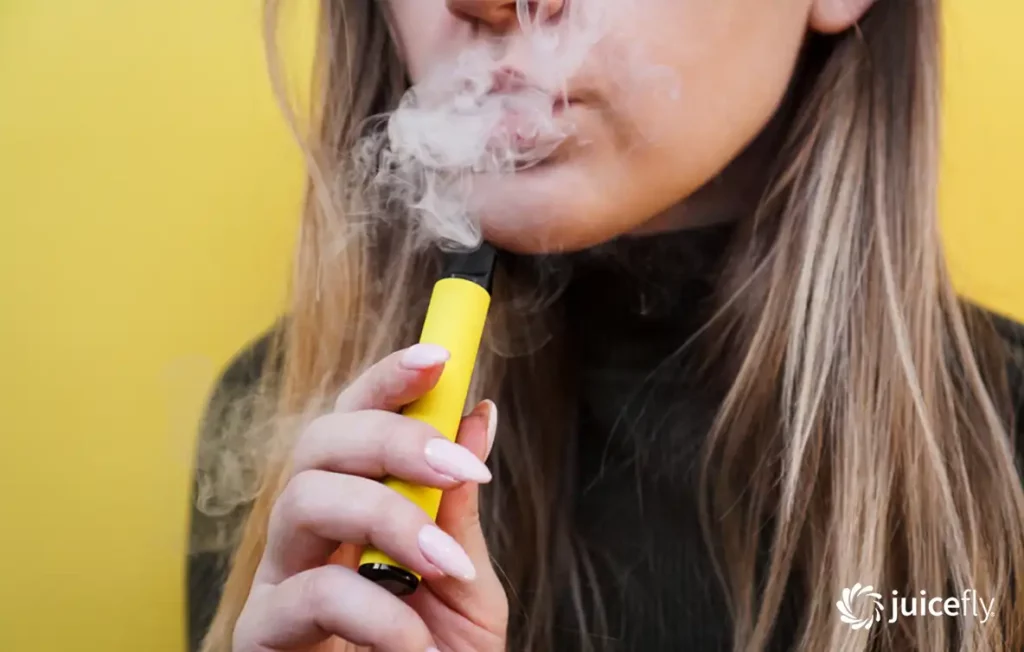
For years, cigarette smokers have been searching for a healthier alternative to combat their nicotine cravings.
When vaping first emerged on the scene over a decade ago, it was a revelation – here was a way to satisfy smokers’ needs for nicotine without many of the harsh chemicals found in cigarettes. However, while vaping is widely accepted as less harmful than smoking, questions have remained about the nicotine levels in vapor compared to smoking.
In this post, we’ll take a deep dive into the research on nicotine levels in vape liquid and vapor versus cigarettes to get some concrete answers.
Let’s get started!
Comparing Nicotine Content: Cigarettes Vs Vapes
On average, a cigarette carries around 12mg of nicotine. This contrasts with vapes which use e-liquid, usually capped at 20mg per ml in a 2 milliliter reservoir. However, your body only absorbs 1mg to 2mg from smoking a cigarette due to how it’s smoked, while how much you absorb from vapes can vary largely based on the strength of e-liquid used.
Consider for instance, walking into a cloud-filled room versus sipping steam off a hot cup of cocoa – the way you interact with each source affects the amount of nicotine absorption. Now, imagine that each puff has its unique story, and we’re just beginning to peel back the layers.
In understanding the nicotine content in cigarettes versus vapes, we must first consider the absorption rate. A smoker absorbs between 1mg and 2mg of nicotine from a single cigarette, with only a fraction being inhaled, generally about a 10th. This means that while the average nicotine content in a cigarette is around 12mg, the amount absorbed by the body per cigarette is much lower.
On the other hand, vapes offer a different scenario. The popular vapes come in nicotine strengths of 0mg, 10mg, and 20mg/ml. This means that a 2ml vape can contain 0, 20mg, or 40mg of nicotine. A 20mg/ml vape, with 40mg of nicotine, is equivalent to smoking one or two packs of 20 cigarettes.
This difference is significant and directly impacts the nicotine intake for individuals who use vapes compared to traditional cigarette smokers.
Finding the right balance between nicotine levels in vapes is key for former cigarette smokers who are transitioning to vaping as it can have a significant impact on their cravings.
Understanding this variation in nicotine absorption rates and strengths is crucial in deciphering the contrasting effects on the body when comparing cigarette smoking to vaping.
Determining Nicotine Levels in Cigarettes and Vapes
When it comes to nicotine, it’s not just about the numbers. Understanding how much nicotine is present and how much is actually absorbed by the body makes a significant difference in accurately gauging your nicotine intake. Cigarettes and vape types differ not only in the amount of nicotine they contain, but also in how this nicotine is absorbed by the body.
A typical cigarette contains a variable amount of nicotine, ranging from 8mg to 20mg per stick, with an average of around 12mg per cigarette. In contrast, vape e-liquids usually come in nicotine concentrations ranging from 0 to 50 milligrams per milliliter. While the concentration in vapes seems higher, it’s essential to understand that only a fraction of the nicotine inhaled from vaping is actually absorbed by the body.
Absorption Rate
The absorption rate of nicotine differs significantly between vaping and smoking. When you light up a cigarette, you absorb between 1 milligram and 2mg of nicotine, but only a fraction is actually inhaled, generally thought to be about a 10th. However, studies have shown that the absorption rate of nicotine from vaping can be faster than from smoking cigarettes, potentially leading to a higher addiction risk.
To put this into perspective, a 20mg/ml vape with 40mg of nicotine is equivalent to smoking one or two packs of 20 cigarettes. This highlights the importance of understanding the concentration and absorption rates to make informed choices about your nicotine intake.
Adjusting Nicotine Levels
When using vapes, users have more control over their nicotine intake as they can choose e-liquids with different strengths. It’s recommended that smokers of regular straight cigarettes choose a vape that offers approximately 20mg of nicotine for a similar experience.
Think of it like choosing your coffee strength—some prefer it strong while others like it milder. Vaping allows for a similar kind of personalization where users can tailor their nicotine intake to meet their individual needs.
Understanding these differences between cigarettes and vapes empowers users to make informed choices about their nicotine consumption and provides valuable information for those looking to transition away from traditional smoking methods.
Examining Health impacts of Traditional and Electronic Smoking
When comparing traditional cigarette smoke to vaping, it’s crucial to acknowledge that cigarette smoke contains over 7,000 chemicals, with at least 69 known to cause cancer. The combustion of tobacco releases harmful substances such as tar and carbon monoxide.
These are some of the reasons why smoking is widely known to be harmful to health. The inhalation of these toxic chemicals from smoking is a significant concern and a major contributor to various health issues such as cardiovascular diseases, respiratory problems, and an increased risk of developing cancers.

Now, let’s talk about vaping. Vaping involves inhaling an aerosol, not smoke, created by heating a liquid that usually contains nicotine, flavors, and other additives. It’s generally agreed upon that the aerosol from vaping contains fewer harmful chemicals than the cocktail of toxins found in cigarette smoke. However, this doesn’t mean that vaping is completely harmless. There are concerns regarding the long-term health impact of vaping since it’s a relatively new phenomenon.
Research into the behavioral impact of vaping is ongoing, aiming to determine whether vaping contributes to increased tobacco use or if it indeed helps reduce smoking rates among adults while also preventing young people from starting to smoke.
Transitioning: From Cigarettes to Vapes
Making the transition from smoking cigarettes to vaping is a significant change but can be an effective step towards curbing nicotine consumption. The beauty of vaping lies in its customizable nature—vapers can easily adjust their nicotine levels, giving them greater control over their intake.
Given that your body is used to a certain amount of nicotine from cigarettes, it’s essential to make a smooth transition without overdoing it. Whether you’re easing off or quitting altogether, starting with a lower concentration is advisable for beginners.
6mg/ml – The Starting Point: When switching from smoking to vaping, it’s suggested that mouth-to-lung setups begin with a 6mg/ml strength e-liquid. This level often delivers a satisfying sensation akin to smoking traditional cigarettes. It allows individuals to get accustomed to the feeling of inhaling and exhaling vapor while providing a balanced starting point for those looking to reduce their dependence gradually.

The Slow and Steady Approach: Shifting from cigarettes to e-cigarettes can initially feel challenging, especially as it requires breaking a well-established routine. However, this change can assist regular smokers in stepping down their nicotine intake gradually. By gradually reducing the nicotine content in the e-liquids they use, smokers have the ability to taper off their nicotine dependency while still having something in hand that imitates their familiar smoking habits.
Once individuals begin feeling comfortable using 6mg/ml e-liquids, they can further decrease the nicotine concentration by mixing e-liquids of varying strengths based on their preference. This flexibility empowers users to take charge of their nicotine consumption through incremental adjustments and serves as a gentle way to ease off nicotine slowly.
Nicotine addiction is undoubtedly a concern with vaping; however, the tailored approach it offers can be pivotal for smokers aiming to reduce or eliminate their reliance on nicotine altogether through careful and personalized adjustments.

